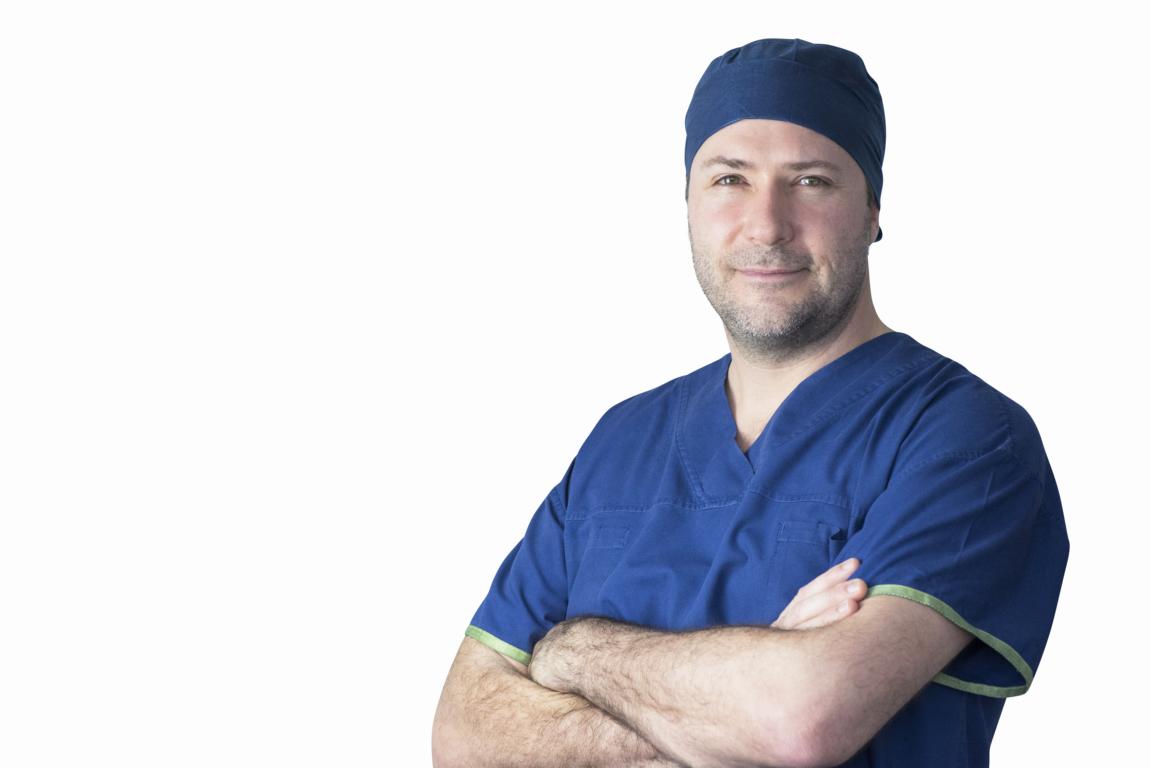PROFESSIONAL PROFILE
BSc/BE (Hons), MBBS (Hons), FRACS
Neurosurgery
DR JEREMY RUSSELL
Mr Jeremy Russell is an Australian trained neurosurgeon who manages all general neurosurgical conditions.
He has subspecialty expertise in both cerebrovascular and skull base neurosurgery, having obtained fellowships in both areas at the Toronto Western Hospital in Canada over a period of two years under world renowned neurosurgeons Prof Michael Tymianski and Prof Fred Gentili respectively.
Mr Russell uses the latest in imaging techniques, including Stealth Neuronavigation, functional MRI and cerebrovascular reactivity testing in formulating decisions for treating patient conditions and planning their surgeries.

For cerebral aneurysm cases, Jeremy utilises minimally invasive craniotomy techniques to enhance recovery times. For all cerebrovascular cases (aneurysms, AVMs, dAVFs, and bypass for moyamoya disease) he uses state of the art intra-operative technology to perform angiograms (vessel imaging). This ensures real-time evaluation of the brain blood vessels and maximises removal of the intended pathology and patency of surrounding vessels, thus reducing the potential risk of stroke to patients.
His brain and spinal patients are offered neuro-monitoring where appropriate, providing the surgeon with instantaneous feedback on the patient’s nervous system function. This allows real-time intra-operative modifications to surgery, therefore averting stroke injuries which would not otherwise be discovered until after the procedure and often too late.
Jeremy also manages all degenerative and tumour spinal conditions, employing minimally invasive or keyhole techniques and computer navigation when indicated to enhance patient recovery.
Jeremy’s guiding principle is to avoid surgical intervention where possible. When this is not achievable, he believes that taking a collaborative approach to patient care is imperative for their treatment. He works alongside a broad range of top specialists to ensure that his patients receive a customised and inclusive solution to their condition.
With all these experienced minds in the one place; dedicated to one goal – your recovery – your care will be discussed from multiple academic perspectives. This collaborative approach allows Dr Russell to formulate a tailored and holistic solution to your brain or spinal condition.
QUALIFICATIONS
Cerebrovascular Fellowship (Toronto Western Hospital)
Skull Base Oncology Fellowship (Toronto Western Hospital)
FRACS (Neurosurgery)
MBBS (Hons)
BSc/BE (Hons)
PUBLICATIONS
- The Woven EndoBridge (WEB) device for the treatment of intracranial aneurysms: initial clinical experience in an Australian population
- Part 1: Clinical Pharmacology of Antiplatelet Drugs for Neurointerventionalists
- Spontaneous regression of Calvarial Ewing sarcoma with FUS-ERG fusion
- Licina A, Silvers A, Laughlin H, Russell J, Wan C. Proposed pathway for patients undergoing enhanced recovery after spinal surgery: protocol for a systematic review. February 2020:1-8. doi:10.1186/s13643-020-1283-2.
- Maingard J, Phan K, Lamanna A, Kuan Kok H, Barras Christen, Russell J, Hirsch J, Chandra R, Thijs V, Brooks M, Asadi H. Rescue Intracranial Stenting After Failed Mechanical Thrombectomy for Acute Ischemic Stroke: A Systematic Review and Meta-Analysis. World Neurosurg. 2019;132:e235-e245. doi:10.1016/j.wneu.2019.08.192.
- Licina A, Russell J, Silvers A et al. Subcutaneous sumatriptan for the treatment of postcraniotomy pain (SUPS trial): protocol for a randomised double-blinded placebo controlled trial. BMJ Open. 2019;9(8):e032388. doi:10.1136/bmjopen-2019-032388.
- Li K, Barras CD, Chandra RV, Kok HK, Maingard JT, Carter NS, Russell JH, Lai L, Brooks M, Asadi H. A Review of the Management of Cerebral Vasospasm After Aneurysmal Subarachnoid Hemorrhage. WNEU. 2019;126:513-527. doi:10.1016/j.wneu.2019.03.083.
- Rosen C, McKetton L, Russell J, et al. Long-term changes in cerebrovascular reactivity following EC-IC bypass for intracranial steno-occlusive disease. Journal of Clinical Neuroscience. 2018;54:1-6. doi:10.1016/j.jocn.2018.06.009.
- Russell JH. Management of colorectal cancer patients with brain metastases. ANZ J Surg. 2018;88(3):125-126. doi:10.1111/ans.14416.
- Voisin MR, Sasikumar S, Russell JH, Zadeh G. One and a half syndrome following penetrating head injury: Case report. J Clin Neurosci. 2017;41:88-90. doi:10.1016/j.jocn.2017.03.008.
- Hughes S, Barry J, Russell J, Bell R, Gurung S. Can giraffes be supersized? Response to ‘Why vascular siphons with sub-atmospheric pressures are physiologically impossible in sauropod dinosaurs’. J Exp Biol. 2016;219(Pt 13):2079-2080. doi:10.1242/jeb.141879.
- Hughes S, Barry J, Russell J, Bell R, Gurung S. Neck length and mean arterial pressure in the sauropod dinosaurs. J Exp Biol. 2016;219(Pt 8):1154-1161. doi:10.1242/jeb.137448.
- Abdul Jalil MF, Russell J, Delatycki M, Gonzalvo A. Congenital biparietal foramina presenting with multiple concussions. Clin Neurol Neurosurg. 2016;145:6-7. doi:10.1016/j.clineuro.2016.03.013.
- Russell JH, Kelson N, Barry M, Pearcy M, Fletcher DF, Winter CD. Computational Fluid Dynamic Analysis of Intracranial Aneurysmal Bleb Formation. Neurosurgery. 2013;73(6):1061-1069. doi:10.1227/NEU.0000000000000137.
- Dimou J, Russell JH, Jithoo R, Pitcher M. Sacral ganglioneuroma in a 19-year-old woman. J Clin Neurosci. 2009;16(12):1692-1694. doi:10.1016/j.jocn.2009.02.045.
- Russell JH, Joseph SJ, Snell BJ, Jithoo R. Brown-Sequard syndrome associated with Horner’s syndrome following a penetrating drill bit injury to the cervical spine. J Clin Neurosci. 2009;16(7):975-977. doi:10.1016/j.jocn.2008.02.025.
- Russell JH, Gaillard F, Drummond KJ. A mass in the fourth ventricle. J Clin Neurosci. 2009;16(3):425-482.
Book Chapters
- Russell JH, Tymianski M. “Chapter 41: Superior Cerebellar Artery Aneurysms.” Decision Making In Neurovascular Disease. New York: Thieme, 2018. 277-282. Print.
International Conference Presentations
- Importance of MCA Bifurcation Patency on Cerebral Revascularization Surgery
2019 Sep WFNS – Beijing China - Importance of MCA Bifurcation Patency on Cerebral Revascularization Surgery
2017 Aug NSA – Coolum Australia
Media
- Hawthorn East woman’s dramatic fight for survival following dangerous brain bleed
Herald Sun, Nov 2019 https://www.heraldsun.com.au/leader/inner-east/hawthorn-east-womans-dramatic-fight-for-survival-following-dangerous-brain-bleed/news-story/acbd98cd65d3412fecc4b3b43a2fabfd
AHPRA REGISTRATION
AHPRA #: MED0001204036
AFFILIATIONS
- Fellow of the Royal Australasian College of Surgeons (FRACS)
- The Neurosurgical Society of Australasia (NSA)
- Member of Congress of Neurological Surgeons (CNS)
- Member of American Association of Neurological Surgeons (AANS)
- Member of Trigeminal Neuralgia Association Australia (TNAA)
- Consultant Neurosurgeon Austin Hospital (public hospital)
- Consultant Neurosurgeon Epworth Richmond Hospital (private hospital)
- Consultant Neurosurgeon Cabrini Malvern Hospital (private hospital)
- Consultant Neurosurgeon Peninsula Private Hospital (private hospital)
- Consultant Neurosurgeon Mulgrave Private Hospital (private hospital)
- Consultant Neurosurgeon Holmesglen Private Hospital (private hospital)
- Founder of Neurovascular Multidisciplinary Team at Austin Hospital
